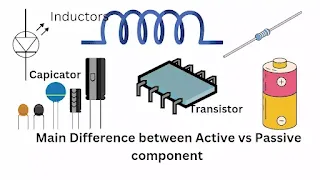Difference between Active and Passive Components (Electronics)
Active and passive components are two broad categories of electronic components used in electronic circuits. The main difference between these two categories is that active components can produce power gain or amplify signals, while passive components do not have this capability.
Passive components are those components that do not require an external source of power to function. They include components such as resistors, capacitors, inductors, transformers, and diodes. Passive components are primarily used to control the flow of current and voltage in a circuit, and to store and release electrical energy. They do not have the ability to amplify or generate energy.
Active components, on the other hand, are those components that require an external source of power to function. They include components such as transistors, op-amps, amplifiers, and voltage regulators. Active components have the ability to amplify and generate energy, and they are used to control and manipulate signals in a circuit.
In summary, passive components are used to control the flow of current and voltage in a circuit, while active components are used to amplify and generate energy. Both types of components are essential in electronic circuits, and they work together to achieve the desired functionality of the circuit.
This is the difference of Active & Passive Components in Basic
| Active Components | Passive Components |
|---|---|
| Requires an external power source to function | Does not require an external power source to function |
| Can amplify and generate energy | Cannot amplify or generate energy |
| Examples: transistors, op-amps, amplifiers, voltage regulators | Examples: resistors, capacitors, inductors, transformers, diodes |
| Used to control and manipulate signals in a circuit | Used to control the flow of current and voltage in a circuit |
| Can produce power gain | Cannot produce power gain |
| Higher complexity and cost | Lower complexity and cost |
Here's a table summarizing the main differences between active and passive components:
| Active Components | Passive Components |
|---|---|
| Require an external power source to function, and can be used to amplify and generate energy | Do not require an external power source to function, and cannot amplify or generate energy |
| Examples include transistors, op-amps, amplifiers, voltage regulators | Examples include resistors, capacitors, inductors, transformers, diodes |
| Used to control and manipulate signals in a circuit, and can produce power gain | Used to control the flow of current and voltage in a circuit, and cannot produce power gain |
| Can have complex and nonlinear behavior, and may require biasing or feedback to function correctly | Have simpler and more linear behavior, and can be used in a wide range of applications |
| Can be sensitive to temperature, noise, and other environmental factors, and may require special handling and cooling | Are generally more robust and less sensitive to environmental factors |
| Can be more expensive and require additional circuitry and design considerations | Are generally less expensive and easier to implement |
| Examples of active circuit applications include amplifiers, oscillators, and voltage regulators | Examples of passive circuit applications include filters, attenuators, and voltage dividers |
Conclusion
Overall, both active and passive components have their own unique advantages and disadvantages, and are used in by considering various parameters, different types of circuits depending on the desired functionality and performance requirements. Active components are generally more complex and expensive, but offer the ability to amplify and generate energy, while passive components are simpler and more versatile, but cannot produce power gain


